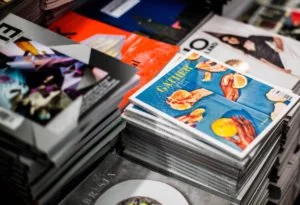In a world where visual design reigns supreme, history has shown us how technological advancements have allowed society to move from black-and-white to colored television. That said, the TV sets of today have nearly as much functionalities as a computer, all while no longer looking like a box with a window on one side. Printers are no different. To be more specific, computer printers reflect the same transition from colorless to colorful as the times have changed.
From the most basic of colors, printer capabilities have evolved, and now include metallic ink printing. While it may seem like a basic concept, adding the spectrum of such real-world colors into the wheel can be quite tricky. Gold, for example, is more than a simple mix-and-match of yellow, brown, orange, and black layers.
So, What is Metallic Ink?
In the printing world, metallic ink describes the range of ink colors that serve to transfer metallic properties unto the surface or substrate of a printing project. This type of ink, which usually includes steel and/or aluminum, gold, silver, copper, and bronze, among others, has metal particles that rise to the surface when the ink dries up, thus allowing light to bounce off the solution. This gives that sheen to these metallic colors. With metallic ink printing, there’s this sort of shiny finish to expect. After all, these colors are reflective of actual alloys; the combination of different chemical elements. It’s more than your usual cyan, magenta, yellow, and black (CMYK).
How to Print Using Metallic Ink
When printing with metallic ink, it is important to know that since these colors have different particles in their solution, metallic ink is considered a spot color. Offset printers use this term to describe non-standard types of printer ink, which means that metallic inks are pre-mixed and produce colors outside of the usual four to six spot colors, CMYK-OG. This then entails that metallic ink printing come with the adequate research and preparation regarding printer capabilities. At this point, one may be wondering, “How to print using gold ink?”
It may sound complicated, but metallic ink printing has a lot more to do with experience in design, and knowing what makes metallic colors resonate at peak quality. Printing documents with highlighted text in gold ink can be done through the careful designation of layers. However, as a rule of thumb, it is best practice to do a trial run, as metallic inks often exhibit high rub resistance. This means that the application of some coating might be necessary to achieve the desired quality of metallic inks.
When applying a protective coating on top of the substrate’s surface, metallic ink can work better. Depending on the way that the ink reacts to the coating, there are instances when there might be adhesion issues. When the protective coating does not react well with the metallic ink, it can lessen the steely, heavy duty effect on the print. It is recommended that harder and less porous stock is used for metallic ink application, but the range of coats and how they work vary across different substrates.
On the other hand, deciding to use metallic ink on uncoated stock will probably yield a duller metal finish, as the ink is absorbed by the paper. If this happens, the printer may apply two layers or thicker ink, so that color clarity cuts through the pores of the stock. As mentioned earlier, metallic ink printing requires some experience in the print and design process, which is why there are specific uses for metallic ink. It helps to be aware of metallic ink printing’s common uses to avoid unwanted errors that can come with exorbitant costs.
The Common Uses of Gold Ink Printing
Imagine designing your bedroom, draping everything in pure gold, from vinyl banners to wall graphics—sounds like quite a sight, right? Hold the press, though, because if you are no oil sheikh, then you have no right to turn everything you own into gold. Listed below are the common uses for metallic ink printing, from your usual shimmering gold to exquisite silver, eccentric bronze, or brutalist copper.
- Embossed Printing – Creating products with gold prints that highlight the embossed elements in a printing project is one way to showcase some flair for either elegance or swagger. Invitations, letter envelopes, business cards, and brochures are a few examples of commonly embossed print products that go well with metallic ink.
- Digital Printing – Us hoi polloi are more than familiar with the household inkjet printer, which is an example of digital printing. It is a printing method that uses digital copies and transfers them unto different substrates, such as paper, canvas, fabrics, photo paper, and many more. Commercial digital printers have the same capabilities, but on a larger scale, both in size and volume. To print gold ink through a digital printer can yield mixed results, but in general, a lot of DIY products start as digital projects. Be creative and experiment with metallic inks, as digital printing is an affordable method to tinker around with.
- Foil Printing – Similar to embossed printing, foil printing is a method that utilizes gold ink to accent a variety of products. Also referred to as foil stamping, foil printing is another way to embellish printing projects with vividly glorious elements. The metallurgy of the metallic ink comes to life with foil printing, thus making more impact with its visual texture. Wedding invitations, product packaging, and food labels are some examples of the usual foil printing projects. Are these not excellent ways of expressing a sense of grandeur?
What Metallic Ink Printing Can Give You: A Vibe That Transcends Real Fortune
From dots and lines to black ink, and later on, grayscale and colored—technology will keep pushing us forward, and the printing industry can only keep evolving. While there are challenges and limitations in how metallic ink is used in today’s printing world, the results—when executed accordingly—are always something to behold. Seeing print products with gold flakes accenting a beautiful design remains to be an impressive sight. We all know it’s not real gold when we lay our eyes on such products, but the allure is all the same. Oh, shiny objects. What about you; do you like metallic colors?



